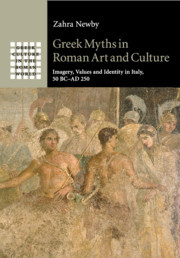Description
Greek Myths in Roman Art and Culture
Imagery, Values and Identity in Italy, 50 BC–AD 250
Greek Culture in the Roman World Series
Author: Newby Zahra
A new reading of the portrayal of Greek myths in Roman art, revealing important shifts in Roman values and identities.
Language: English
Greek Myths in Roman Art and Culture
Publication date: 01-2020
Support: Print on demand
Publication date: 01-2020
Support: Print on demand
Greek Myths in Roman Art and Culture
Publication date: 09-2016
406 p. · 18x25.4 cm · Hardback
Publication date: 09-2016
406 p. · 18x25.4 cm · Hardback
Description
/li>Contents
/li>Biography
/li>
Images of episodes from Greek mythology are widespread in Roman art, appearing in sculptural groups, mosaics, paintings and reliefs. They attest to Rome's enduring fascination with Greek culture, and its desire to absorb and reframe that culture for new ends. This book provides a comprehensive account of the meanings of Greek myth across the spectrum of Roman art, including public, domestic and funerary contexts. It argues that myths, in addition to functioning as signifiers of a patron's education or paideia, played an important role as rhetorical and didactic exempla. The changing use of mythological imagery in domestic and funerary art in particular reveals an important shift in Roman values and senses of identity across the period of the first two centuries AD, and in the ways that Greek culture was turned to serve Roman values.
Introduction: Greek myths, Roman lives; 1. Art and power in the public sphere; 2. Recreating myth in the Roman villa; 3. Paideia, rhetoric and self-representation: responses to mythological wall-paintings; 4. Mythological wall-paintings in the Roman house; 5. From home to tomb: myths in the funerary realm; 6. The rhetoric of mythological sarcophagi: praise, lament and consolation 7. Epilogue: the Roman past, the culture of exemplarity and a new role for Greek myth.
Zahra Newby is Reader in Classics and Ancient History at the University of Warwick. She is author of Greek Athletics in the Roman World: Victory and Virtue (2005) and numerous articles on Philostratus and Lucian, Greek cultural identity in the imperial period, as well as on mythological sculpture and sarcophagi. She also co-edited the volume Art and Inscriptions in the Ancient World (Cambridge, 2007).
© 2024 LAVOISIER S.A.S.
These books may interest you

Art and Rhetoric in Roman Culture 138.85 €




